When is a toys-to-life game not a toys-to-life game? Seemingly, the answer is "when it's Starlink", as, although Ubisoft's promising space sci-fi epic has been marketed as a toys-to-life game, it doesn't actually seem to want to make use of the toys at all.
"Borrowing" heavily from No Man's Sky both in terms of gameplay and visuals, Starlink is a game that was purported to be trying to put toys-to-life back on the map. After the untimely demise of Disney Infinity and LEGO Dimensions, followed by the surreptitious shelving of Skylanders, things have been all too quiet on the toys-to-life front for some time, with Ubisoft, quite rightly, thinking there was a sizeable market there that was ripe for the picking. Enter Starlink, a game with the voice acting of a Saturday morning TV show, a decent space exploration game lying beneath the surface, and absolutely no reason to touch the expensive toys you've piled up at all.
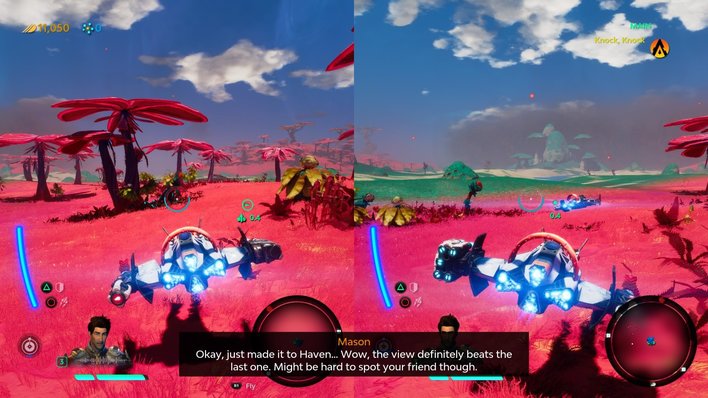
It's certainly bright enough
The story here is beyond convoluted and incredibly poorly explained, so you'll have to excuse us if we gloss over the details. When a famous scientist called St. Grand (note: how he achieved sainthood is unclear) gets kidnapped by a load of bad guys knows as the Legion, it falls to his young, cookie cutter group of rookies to scour the galaxy to get him back. The problem, however (outside of the one voice actor pronouncing "plague" as "plagg"), is that almost all of story is delivered through lengthy back and forth conversations, which seem to exclusively trigger themselves when you're in the middle of an attack by more enemies than you've ever seen before. Trying to understand interplanetary geopolitics when you've got explosions ringing in all ears isn't all that simple, and it's mind boggling that no-one at the developers thought that perhaps this might be a bad idea.
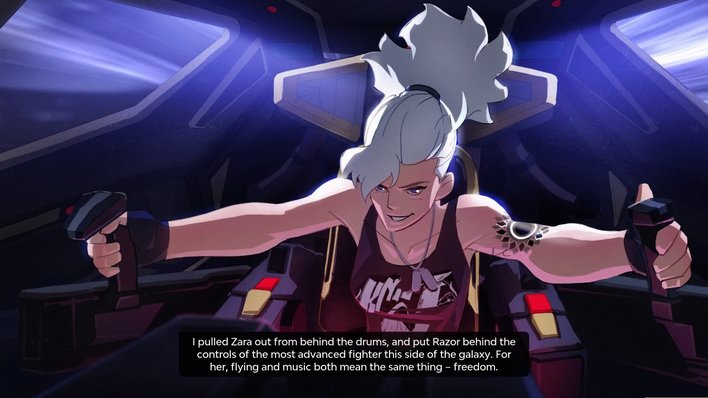
Even in the odd cutscene, they do their best to be confusing. Zara and Razor are the same person - but you wouldn't know it from the dialogue.
This being a Ubisoft game, there's a kind of "open world" vibe to proceedings here, with a main storyline that sees you trying to win over each of the game's seven planets, and drive the legion away. With a huge emphasis on exploration, you'll be heading into uncharted territory as you explore the game's vibrant worlds, scanning uncharted creatures for scientists, fortifying outposts, helping out explorers, and discovering ancient mystical artifacts (most of which just so happen to contain ship parts that are fully compatible with your craft). Oh, and seeing as it's worth mentioning before we get any further - the whole thing's fully playable in co-op out of the box, without having to buy any extras, although player two will have to use the same ship as you.
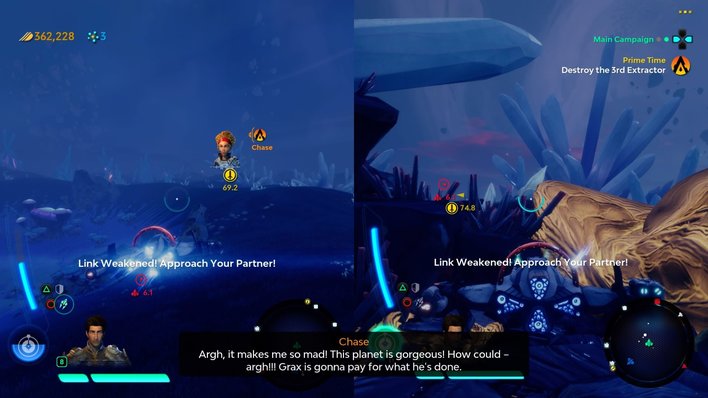
You'll need to stay at least vaguely close to your partner at all times. Luckily, you can press a button to automatically follow your partner, so you'll never get lost!
What's perhaps most surprising, though, is how little of the game actually revolves around space flight. Instead of flying round the universe, the fastest guy alive, you're instead left bouncing your way over the hills and dales of the game's technicolour planets in a ship that spends most of its time functioning as a glorified landspeeder, scooting just above the surface in an ever-so-cool sci-fi fashion. Weirdly, there's even kind of platforming sections, where you have to leap between buildings by boosting up ramps - an odd idea indeed for a craft that can fly.
So, where do the toys come in? Good question. If you buy the starter pack, you'll get the game's default ship, and three weapons - essentially, a fire, ice and energy weapon. All of the game's weapons are categorised into these sort of elements, with certain weapons working better against certain other enemies - you know the drill. The usual exploitative feeling toys-to-life style tricks are here too, like the fact you only get one life per ship, and if you die, you have to pay (in game currency) to be resurrected at a nearby base, but it's such a minor inconvenience, it doesn't exactly feel like Ubisoft are trying to bleed any money out of you.
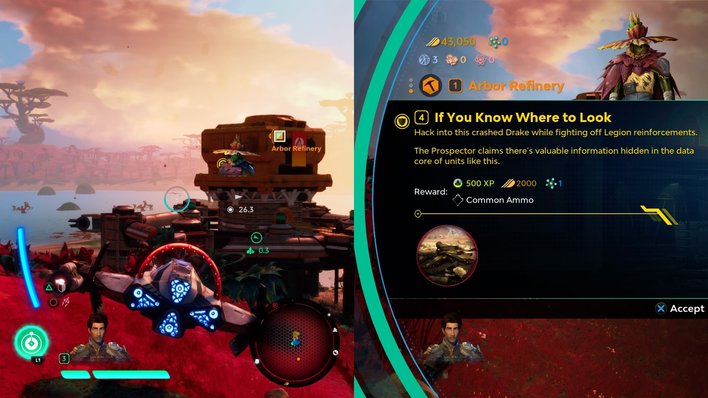
There's dozens, if not hundreds of seemingly auto-generated side quests to do too
Of course, the idea here is you might buy the extra weapons to dish out some bonus damage to some of the game's trickier enemies, and maybe pick up a ship or a character for a bit of stylistic change, but realistically, there's no real reason to buy anything here. And just to be clear, we're not exactly complaining about that, but it seems so odd that a game that claims to be a toys-to-life title doesn't really use the toy at all. In fact, you can choose to play in digital mode and forego the toy altogether. There's even a digital deluxe version which unlocks all the toy-related content, for less than the price of one ship - although then, you technically are just paying for a bunch of unlock codes.
It's lucky, then, that what there is here is actually more fun that you might expect, especially as there's not really that much to it. Relying a lot on the feel good factor of exploring, and Ubisoft's familiar open world mechanics, you can spend hours just pootling about the planet, harvesting materials, exploring for rare stuff, before flogging it to any nearby outposts for some cash. Weirdly enough, along with earning you some money, selling stuff to outposts also upgrades them - and the more powerful the outposts are, the less of a hold the legion will have on the planet. Repeat ad infinitum.
Along with strengthening outposts, there's the odd boss fight to take on too - huge, hulking walkers known as Legion Primes, that just so happen to have glowing red weak spots you can blast for massive damage. Defeating the Primes, or taking out the similarly semi-boss-fight style planet sucking extractors will net you some sort of intergalactic mega parts, which you'll need if you want to add to the planet's selection of bases.
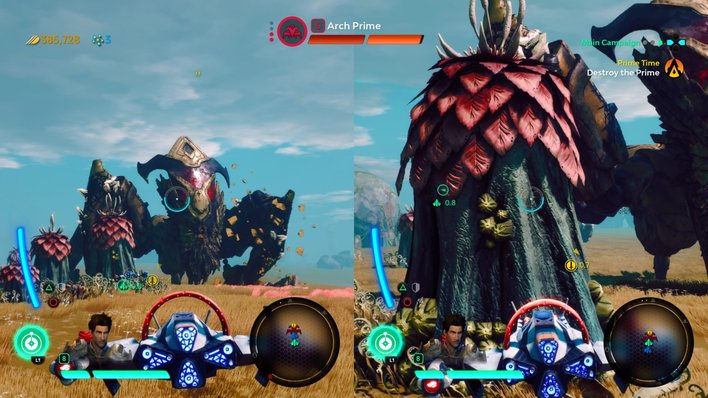
That's one heck of a beard.
Out in space, however, there's really very little to see or do - a few bandits to suck you out of hyperspace and rough you up when you're trying to shorten the ridiculous length of time it takes to get between worlds, and a handful of salvage opportunities - although as soon as you get anywhere near the salvage, the marker telling you where it is will completely disappear, leaving you to try and find your way around a pitch black ship in the depths of pitch black space with barely a candle's worth of light to guide you.
For a game that's presumably been aimed at kids, though, there's a lot of oddness here. For starters, there's some glaring consistency issues. When you pick up minerals, or salvage rare parts, you'll be told you can drop them off at either an outpost, or a prospector for cash. If you dutifully head to the world map to find the nearest place, though, you may be surprised to find that you actually can't find any. And there's a good reason for this - they aren't called prospectors or outposts. By outposts, they mean observatory, and by prospector, they mean refinery. That caused us plenty of confusion to begin with - so make sure you don't slip up either.
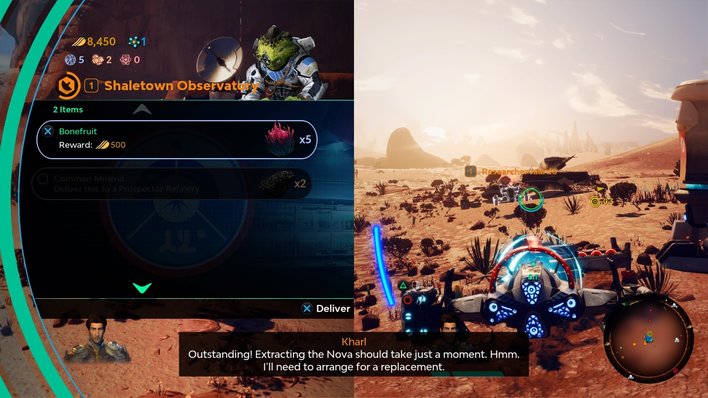
Deliver to a what now?
There's also more than a few issues with the interface, although seemingly the vast majority of these problems comes from the fact the game just drops half the button prompts when you start playing in split-screen. It took us ages to figure out how to drop an item, and there was nothing in the way of a prompt in space to tell you you could use a kind of hyperdrive to warp between planets, rather than taking a good five or ten minutes to trundle there at normal speed. Outside of split-screen, however, there's big friendly pop-ups - which does beg the question, why do Ubi think those playing in co-op need fewer prompts?
In all, then, Starlink is really weird game, yet one that's actually a decent amount of fun. If you're a toys-to-life fan, then this isn't going to be the stop gap you were looking for - there's no real element of collecting here, and no real impetus to get 'em all - in fact, there's barely any reason to really buy anything. However, if you're looking for a co-op space adventure, you're a fan of stuff like Lylat Wars/Star Fox, or you've ever wished No Man's Sky was more fun, and had a split-screen co-op mode, then Starlink could be well worth a look.
Format Reviewed: Playstation 4


















